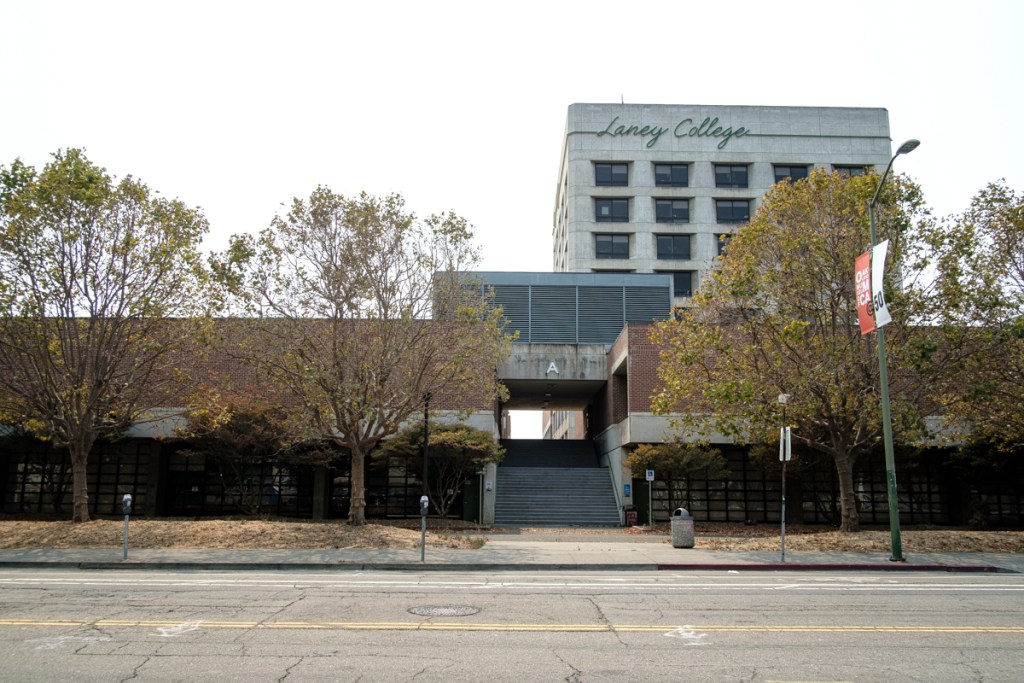
Tuition is currently free at the Peralta Community College District’s four schools—but living in the East Bay isn’t.
A group of Peralta students and alumni, including some homeless students, is urging the district to build housing near its campuses in Oakland, Berkeley, and Alameda, so high rents and housing insecurity don’t prevent anyone from getting an education or building skills for a career.
Peralta leaders say they expect to receive a significant grant from the state for this purpose, and have presented initial plans for developing a dormitory with up to 300 beds on district-owned land at College of Alameda.
“I live in my vehicle and I go to school here,” Laney student Jon Sullivan told the Peralta Board of Trustees on Tuesday evening.
A student government representative, Sullivan is also part of the Laney chapter of the Poor People’s Campaign, a national organization focused on systemic poverty. The Laney group wants the district to build 2,000 new student housing units, partner with land trusts to buy hotels, and open student cooperatives modeled on the prominent system at UC Berkeley.
“There definitely needs to be more of a priority around housing for families,” added Sullivan on Tuesday. “Lots of our students have dependents and spouses.”
In 2021, state law AB 169 set aside $500 million for college student housing, including $25 million in planning grants for community colleges. Peralta officials say the district is in line for $440,000 from that planning fund, pending state approval of a complete application that’s due in July.
At an April board meeting, a consultant with Volz Company, a real estate strategy firm hired by the district to work on the AB 169 grant, told trustees that all four Peralta campuses were considered, but the Alameda site was determined to be the most competitive for the funds largely because it’s closest to being “shovel-ready” for construction and would be more affordable for the district, which owns the land and could also keep rents lower.
Students at any of the schools would be able to live in the Alameda dorm, where 80% of the rooms would be double occupancy in order to keep costs down, said AJ Yoon, vice president of Volz Company.
Volz surveyed 716 Peralta students and found that 80% of respondents would be considered low-income, 29% had to find housing in order to attend their Peralta school, and 69% said it was a challenge to find housing within their budget. When asked where they reside, the ZIP code that the largest number of students listed was in Alameda.
But the Alameda dorm location was a sticking point for the students and alumni who addressed the board Tuesday.
“If housing is going to be built at College of Alameda, there is a real need around transportation,” said Sullivan, who suggested that the district consider a shuttle system. “It’s not a central hub like Laney or even [Berkeley City College], where there’s more access to BART and AC Transit.”
Lashawn Tolliver, a Peralta student who’s unhoused, said housing is not the only support that the district should provide students experiencing homelessness. He said he’s been given the “runaround” when he’s gone looking for connections to social services or resources in a crisis.
“My vehicle was just towed—that was my residence,” Tolliver told the board. “I feel that Peralta…is severely undeserving a big population of its students, particularly the natives of Oakland that have such a difficult time getting reasonable accommodations.”
School systems across the East Bay—not only Peralta—are confronting a shortage of housing available, or affordable, for their students and staff. UC Berkeley houses less than a quarter of its undergraduates, the lowest rate across the UC system. And K-12 districts, faced with shortages of teachers and employees who commute hours to work from cheaper cities, have begun pursuing development of teacher housing.
As part of its contract proposal, the Oakland teachers union currently on strike wants the district to use vacant property and shuttered school sites for “homeless and precariously housed families and staff.” A current project converting the old Oakland Unified School District headquarters is also set to include transitional housing for youth.
Peralta Trustee Nicky González Yuen, who admitted that he “frankly preferred the Laney site,” called the Alameda dorm plan an “experiment” that, should it succeed, will encourage similar projects at other Peralta campuses in the future.
